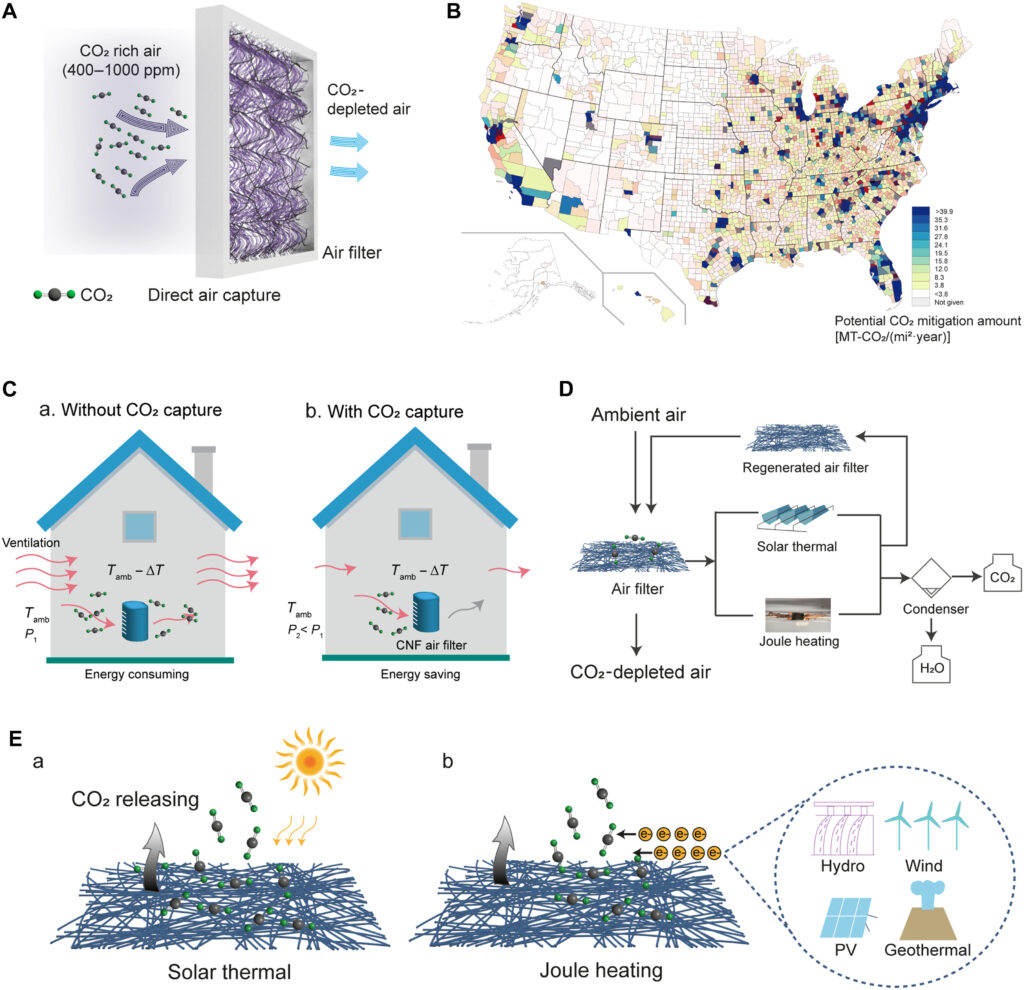This air filter could make your home (and everyone else’s) a carbon-capture plant
Engineers have made a nanofiber filter that fits in building ventilation systems and soaks up CO2 at lower cost than massive direct-air capture plants.
October 23, 2025

Direct air capture, the technology to snag carbon dioxide emissions from thin air, has always been contentious. It requires giant fans to blow large volumes of air across expensive sorbent materials and then heating those materials to release the trapped CO2. Costs have been high, and haven’t gone down much despite a few large projects running for the past few years.
Researchers now say they have a low-cost alternative to large DAC plants. They want to turn houses and buildings into distributed carbon-capture plants with an air filter that passively captures CO2 from building ventilation systems. “Same as rooftops provide existing access to solar energy without additional land use, buildings can also support DAC through the existing ventilation systems,” the authors write in the journal Science Advances,
The concept relies on a simple filter. It is a mat of tiny carbon threads known as nanofibers that are coated with a polyethylenimine (PEI) polymer. The filters could be designed to fit in existing ventilation systems.
The PEI polymer binds with CO2 present in air at low concentrations. The carbon nanofiber filters can hold a large amount of PEI because of their large surface area and porous structure, “leading to a remarkable carbon capture capacity,” the researchers write.
After absorbing CO2 from direct air, the filters could be easily regenerated using sunlight or renewable electricity “with high efficiency and extremely low carbon footprint,” they write. When the carbon nanofibers absorb sunlight or are zapped with short electric pulses, they heat up and release the gas. Both these avenues are more energy-efficient and cheaper than the heating processes used in today’s DAC plants. After the CO2 has been removed, the air filter could be reused.
Chemists have made the best carbon capture material yet
To test the filter, the team passed simulated direct air containing CO2 and nitrogen through the filters at various humidity levels. It efficiently takes up the greenhouse gas without blocking airflow. Over its lifetime, the filter would achieve a net carbon removal efficiency of about 92 percent when regenerated using solar heat, the researchers calculate.
Their economic analysis shows that, for each of ton of CO2 removed, the system would cost $362 if the filters were regenerated using solar heat or $821 with electricity. Today’s large-scale DAC plants cost between $100 to $1000 per ton of CO2 removed.
The technology could have a big impact if deployed widely in home and building ventilation systems. They could potentially capture 25 million tons of CO2 in the US, and 596 millions tons globally, which is about 2% of annual global CO2 emissions. The big logistics hurdle to figure out, of course, would be a way to collect the filters for regeneration and then return them for reuse.
Source: Ronghui Wu et al. Distributed direct air capture by carbon nanofiber air filters. Sci. Adv. 2025
Abstract
The rising atmospheric CO2 concentration is one of the biggest challenges human civilization faces. Direct air capture (DAC) that removes CO2 from the atmosphere provides great potential in carbon neutralization. However, the massive land use and capital investment of centralized DAC plants and the energy-intensive process of adsorbent regeneration limit its wide employment. We develop a distributed carbon nanofiber (CNF)–based DAC air filter capable of adsorbing CO2 downstream in ventilation systems. The DAC air filter not only has the potential to remove 596 MtCO2 year−1 globally but can also decrease energy consumption in existing building systems. The CNF-based adsorbent has a capacity of 4 mmol/g and can be regenerated via solar thermal or electrothermal methods with low carbon footprints. Through life cycle assessment, the CNF air filter shows a carbon removal efficiency of 92.1% from cradle to grave. Additionally, techno-economic analysis estimates a cost of $209 to 668 in capturing and storing 1 tonne of CO2 from direct air.
